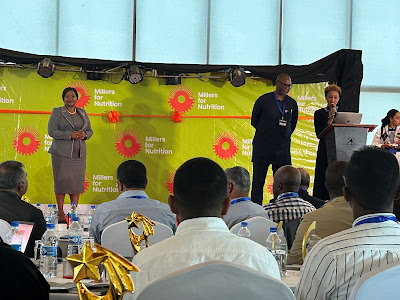In a significant move to address widespread hidden hunger in Kenya, the Market Intelligence Initiative was invited to partake in the launch of the Millers for Nutrition Initiative in Kenya. Millers for Nutrition is a global initiative composed of 8 countries that aim to provide access to safe, nutritious food for all citizens.
Kenya, like many sub-Saharan African countries, faces a critical challenge with micronutrient deficiencies, often referred to as “hidden hunger.” UNICEF, the Kenyan demographic health survey, and WHO estimate that about 40% of women in their reproductive age (15-49 years) suffer from iron deficiency. Furthermore, around 26% of children under the age of five years are affected by iron deficiency anemia. In addition, about 30% of women and men are zinc deficient, and an additional 51% of children under the age of five suffer from zinc deficiency. Iron and zinc deficiencies result in stunted growth, wasting, and cognitive impairments. Vitamin A deficiency affects about 16% of women and men and 33% of children under 5 years.
Millers have been identified as a key group to help ease the burden of hidden hunger through fortification strategies of major staple crops such as maize, wheat, and edible oils. These consumer products are currently fortified in Kenya, with rice gaining greater attention through the Ministry of Health and the Ministry of Investments, Trade, and Industry, which highlighted the importance of safe, nutritious food through the improvement of fortification technology and standards. The rice fortification strategy for Kenya will be launched shortly.
Cereal fortification has been shown to be effective in addressing malnutrition, but the presenters highlighted that this is not always easy to achieve. Food safety issues like aflatoxin contamination often result in poor products. The Kenya Millers Fortification Index (KMFI), an assessment tool developed to monitor and evaluate the progress and effectiveness of fortification programs in Kenya, was implemented through collaborative efforts involving the Kenyan government, the Kenya Bureau of Standards (KEBS), milling companies, and non-governmental organizations.
While fortification may be impactful for maize and wheat as they are usually consumed as flour, rice fortification has proven difficult. Several technologies have been developed like dusting, soaking in micronutrient-rich water, parboiling, and physical processes that repress fortified rice flour into artificial rice grains. However, these technologies all come with their own disadvantages from micronutrients being washed out during cleaning processes, loss of nutrients through cooking in too much water, or high costs associated with specific technologies as well as low consumer awareness and acceptance.
IRRI has developed new biofortified rice varieties that naturally accumulate higher iron and zinc in polished grains than traditional varieties. This biofortification through breeding would be a cost-effective supplement or alternative to the artificial fortification of milled products. “As a key stakeholder, IRRI can provide its expertise in biofortification and market intelligence to make sure that the demands of the consumers and other rice value chain stakeholders are met.”, said IRRI Senior Scientist Melanie Connor.
The new initiative will focus on building trust among stakeholders to generate data that can be used to optimize nutritional impact. Furthermore, it will provide technical assistance for millers of all cereal crops and will galvanize stakeholders to take action. With these, the initiative hopes to have a long-lasting impact and to reduce micronutrient deficiencies considerably. However, the success is highly dependent on consumer acceptance and awareness, a topic that was discussed by several presenters and is still poorly understood and needs attention especially for artificially fortified rice.
###
Learn more about IRRI (www.irri.org) or follow us on social media and networks (all links down the right column).




No comments:
Post a Comment